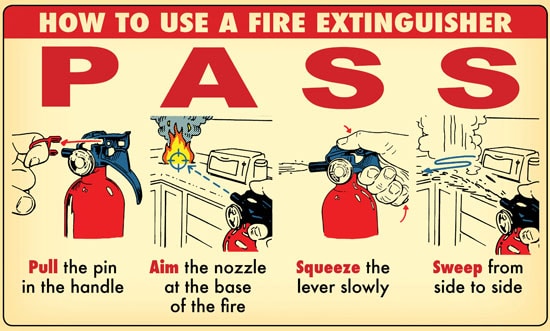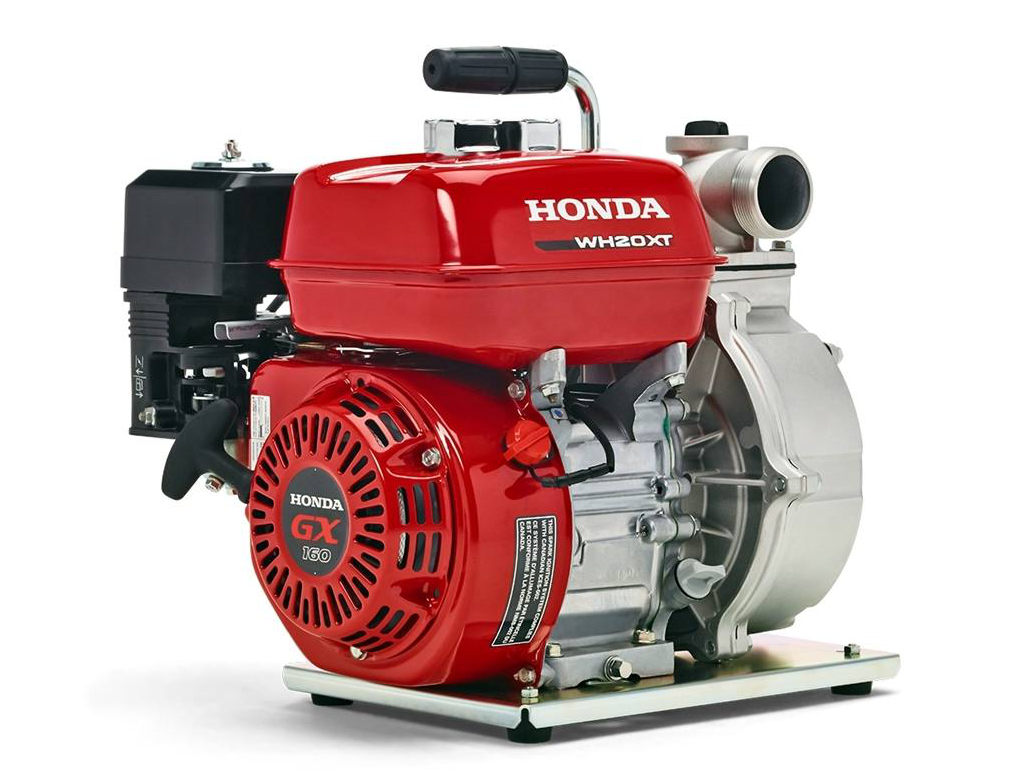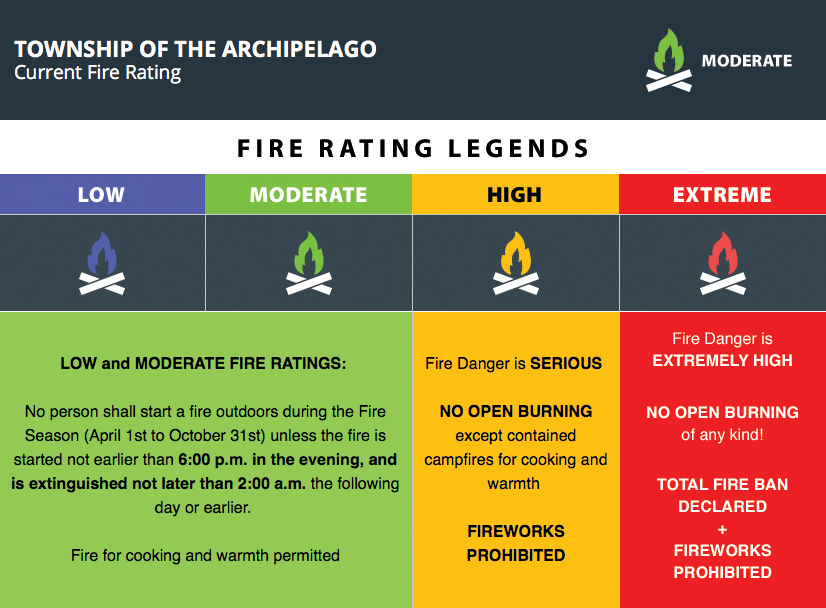Click flames for the township’s current fire rating:
The fire rating system is explained below

There’s much truth to the saying “an ounce of prevention is worth a pound of cure,” particularly when seconds matter. Develop a fire emergency plan, practice and review it with those using your cottage. Here are some tips to consider when developing your plan.
The Township has provided all islanders with a civic address sign to prominently display on your dock. Ensure that all visitors to your property know your island number. Our BNIA Directory has a tear-off listing of emergency numbers on on the back cover. Write your civic address at the bottom and post the list in a prominent spot.
Consult the BNIA Fire Pump Map to locate your neighbours who own fire pumps. To update your own fire pump listing online, go here. This is how you can ”show“ your fire pump status on the online map.
Work with your neighbours, including those who have and don’t have fire pumps. Together, devise a plan so that in case of fire, you can execute immediately. Your plan should include agreements regarding supporting each other and for contacting other islanders for additional support.
Program contact information for neighbours and Bayfield Nares First Responders in your phone for quick access. Post this information prominently in your cottage and review it with visitors (again, see the back flap of the Directory).
Store your pump on a flat surface near the water’s edge, ensuring that the intake hose can reach clear water. Position the hose for easy uncoiling and ensure the nozzle can be attached immediately. Keep your pump full of gas and have additional gas at-the-ready. Identify who on your property is able to start and operate your pump. Regularly start the pump to ensure it is working properly, and practice using it.
Whether or not you have a pump, ensure quick and easy access to a connected garden hose and a good supply large buckets. These are the quickest way to respond to a small fire before it grows out of control.
Get low and get out. Leave your belongings. Stop, drop and roll if your clothes are on fire. Stay well clear of any flammable gas or liquid containers, particularly propane. Execute your plan. Never re-enter a burning building.
Engage immediately. We are each other’s fire department. If you’re able, bring your pump, your buckets and notify others. Don’t underestimate the value of a multi-pronged approach – pumps and a bucket-brigade. Focus efforts on saving property, trees and accessory buildings, not a burning building. Direct fire-fighting efforts to surrounding ground and trees to avoid spread.

A small fire can engulf a building in minutes. According to John Tuck, Captain and Fire Prevention Officer for the Parry Sound Fire Department, portable fire extinguishers can put out small fires or reduce a fire sufficiently to allow escape. Here are some tips gleaned from my recent conversation with John:
ABCs: Fire extinguishers are categorized based on their ability to fight different types of fires. John suggests a portable “ABC” rated extinguisher. This type can be used for most small household fires including trash, wood, paper, flammable liquids and electrical blazes.
Size Matters: The weight on a fire extinguisher refers to the amount of chemical inside, while the canister adds several pounds. For household use, John recommends an extinguisher with 5 pounds of powder, which typically weighs about 10 pounds total.
Refillable vs Single Use: Rechargeable fire extinguishers can be reused after refill by a professional, while single use extinguishers are not refillable. John recommends reusable extinguishers as they have higher quality metal parts that are less prone to leakage than disposables with plastic parts.
Keep It Current: Extinguishers lose pressure over time and require annual servicing. John told me that the Parry Sound Fire Department provides a recharging service. You can drop your fire extinguisher off on Tuesday mornings for inspection and recharge for approximately $10. (Call first: 705-746-2262.)
Location, Location, Location: For an extinguisher to be effective, it must be quickly and easily reached. John suggests mounting the extinguisher away from potential hazards, near an exterior door to ensure safe exit.
Brand Recommendation: Although there are many good models available, John has high praise for the “Amerex B500 5lb ABC Dry Chemical” device. Refillable, reliable, equipped with metal valves, a hose and nozzle, it has 5 pounds of powder, weighs 10 pounds, and has a 14-second discharge at a range of 9–15 feet.

Using Your Extinguisher: Ensure that everyone knows how to use your fire extinguisher. Speed and accuracy are important as most portable extinguishers discharge in less than 10 seconds with a range of under 10 feet. Protect yourself at all times, keep your back to the exit, stand 6–8 feet away from the fire and follow the PASS procedure:
1. Pull the safety pin.
2. Aim the nozzle at the base of the fire, not at the flames.
3. Squeeze/press the trigger while holding the canister upright.
4. Sweep the extinguisher from side to side until it runs dry.
Know When To Go: If the fire is not out after using the extinguisher, safely back out of the area, get outside, close the door and get help.

According to the Government of Canada, fire-prone conditions are predicted to increase across the country in coming years.
In addition to prioritizing fire risk reduction, ready access to a fire pump may enable cottagers to put out a fire or gain time for help to arrive. If you’re considering buying an island pump, here’s a primer.
Pressure: Firefighting requires a high-pressure pump to propel water over distance. Avoid transfer pumps that provide high volume and low pressure as they are designed to move water from one place to another but don’t have the force to fight a fire.
Flow Rate: Flow rate refers to the volume of water that passes through the pump, typically noted in litres per minute. For island use, look for approximately 500L/min.
Inlet/Outlet Size: Water is drawn in through a suction or inlet valve and then sent through an outlet or discharge valve. Port sizes for the valves typically range from 25mm (1″) to 100mm (4″) in diameter. For island use, 50mm (2”) suction and discharge ports are recommended.
Weight/Mobility: As your pump should be mobile, consider its weight and how you will move it around. Look for a lighter-weight portable pump in the 25kg (50lb) range with a handle for easy maneuverability.
Quality Engine: Look for a quality engine with metal components. Honda and Yamaha are leading motors backed by local service agents. Beware of cheap pumps using plastic parts.
Fire Hose: Determine where the pump will be situated on your island and how far the hose will need to reach, keeping in mind the longer the hose, the lower the pressure. Consider lengths of 50ft or 100ft.
Suction Hose and Strainer: Once again, consider how close the pump will be to the water. The standard suction hose length is 20 feet.
Consult a reputable retailer, such as Bobcat of Parry Sound at 25 Woods Road, prior to purchasing a pump. Although there are numerous options available, consider the Honda WH20XTC (pictured). Equipped with fittings, hoses and nozzle, this pump currently costs approximately $1,600 plus tax.
Once purchased, ensure that you and others using your cottage know how to use the pump, that it is well maintained, filled with gas, located near the water, and ready to go. Also, we suggest you declare your pump in your BNIA online profile, so that you and your neighbours can plan fire response together.
Let’s work to prevent fires so we use our pumps for irrigation instead of firefighting!

Humans cause more than half of all wildland fires in Canada. And all it takes is a spark. Please consider and share the following campfire safety tips with family, friends and tenants, remembering that you are your only fire department.
Check and follow open air burning restrictions posted here and on road signage in Pointe au Baril and on Hwy 529A near the Bayfield Transfer Station.
Even if the fire rating allows for open fires, never build a campfire when the weather is windy as sparks carry easily to surrounding brush and trees.
Choose an open area, ensuring that it and nearby crevices are clear of brush, leaves, needles and grass. Ideally, build campfires in fire pits.
Keep campfires to a manageable size of no more than 1 metre (3 feet) high by 1 metre (3 feet) in diameter.
Use kindling rather than flammable liquids to start a fire. Keep all combustible materials, including extra wood, at least 5 metres (15 feet) away from the campfire.
Never leave a campfire unattended. Ensure that a responsible adult is monitoring the campfire at all times.
Keep plenty of water and a shovel nearby to douse the fire. Once water has been applied, stir the wet ashes and douse again with water, ensuring that there is no life left in the flames and that the ground including nearby crevices is cool and moist.
Have a list on hand of Emergency Responders and neighbours to contact for help or additional fire pumps. Do not call 911 and do not call the Township of the Archipelago, as they do not provide fire protection services.
Climate change experts continue to predict hotter, drier summers in our area, increasing fire outbreak risk. Further, the geography and abundance of vegetation in Bayfield-Nares increases our risk of rapidly spreading fire.

Check and ensure that you and your guests follow the open air burning restrictions posted online here, and on road signage in Pointe au Baril, and on Hwy 529A near the Bayfield Transfer Station. Under conditions where open fires are permitted, they may be started after 6 pm and must be extinguished before 2 am.
When the rating is high, fires for cooking and warmth are provided for campers only. When the rating is high, open burning is prohibited for cottagers with access to contained fuel burning cooking appliances or means to escape the cold.
Fireworks are permitted from 6 pm to 11 pm on Victoria Day, Canada Day, Independence Day (US), and one day before and after each of these days. Even on these days, fireworks are prohibited if the rating is high or extreme. All other days of the year, fireworks are prohibited. The use of sky lanterns and firecrackers is prohibited at all times. For complete regulations, see By-law 2017-21 or contact the Township of the Archipelago By-law department at 705-746-4243 Ext. 325.